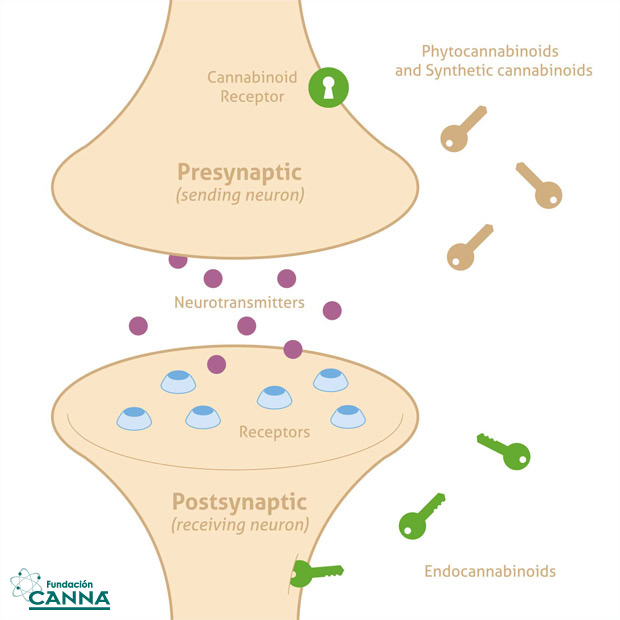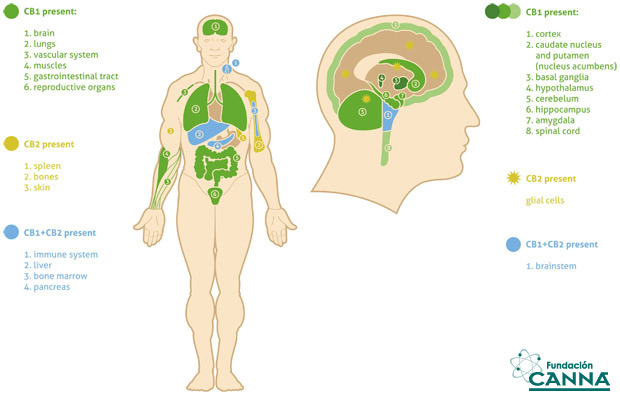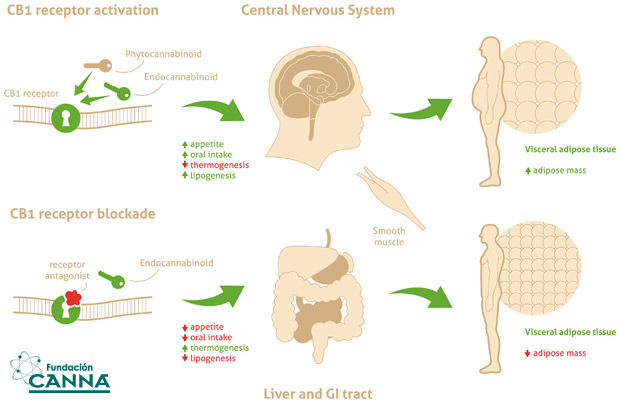To fully understand the encocannabinoid system and its role in the physiological and pathological processes of body systems, we must pay attention to the way our body is formed and what we really are.
Our body is an independent entity capable of receiving certain information from the outside world through the senses and then interpreting and elaborating on it in the brain, to finally allow the rest of our body to interact with such data. This arrangement allows our body to meet needs such as feeding or reproduction, in addition to being aware of both its own self and the outside world. Something much more complex to understand, is the fact that our body is formed by a colony of millions of cells. Each cell is independent, has its individual needs for energy sources and has its own biochemical process to obtain it. These cells are organised according to their function and structural diversity, thus building the different organs. Each organ plays an specific function in the human body in order to keep the whole organism alive. The organ in charge of keeping and controlling the different organ functioning, as well as processing the outside stimuli, is the brain.
We could say that the endocannabinoid system is a intercellular communication system. It basically is a neurotransmission system, although it is much more than that, as it can also be found in other organs and body tissues than the brain. The endocannabinoid system seems to be the enhanced version of an ancestral intercellular communication system found in plants too; the arachidonic acid system. In fact, the endocannabinoids' nature is directly related to arachidonic acid.
Arachidonic acid is an omega-6 fatty acid that participates in the signalling processes of plants and animals. It regulates the defences against infections and the signalling of stress in plants. It also controls animal muscle growth, platelet cumpling, vasodilatation and inflammation.
Picture 1

Endocannabinoid System
The endocannabinoid system is formed by both cannabinoid receptors and endocannabinoids that interact in the same way as a lock and its key (Picture 1). Cannabinoid receptors are cell membrane proteins that act as the lock of the endocannabinoids, which are endogenous ligands of lipidic nature, produced by the different body cells and that act as a perfect keys that join the receptors. This activation gives way to changes in the cells that end up in the final actions of the endocannabinoid system over the physiological body processes. The endocannabinoid system gets involved in a wide variety of physiological processes (i.e. the modulation of the release of neurotransmitters, the regulation of the perception of pain, as well as cardiovascular, gastrointestinal and hepatic functions) that will be explained in further detail later in this article.
The name “endocannabinoid system” makes reference to the fact that this endogenous system is the one affected by the intake of fitocannabinoids, which act as a false key, able to fit the lock of cannabinoid receptors producing a different effect to the one produced by the perfect key, which is represented by the endocannabinoids produced by the body.
Cannabinoids receptors
The two main receptors that form the endocannabinoid system are the CB1 and CB2 cannabinois receptors. It has been accepted recently that the orphan receptor GPR55 can be considered as the third receptor for cannabinoid activity. All these receptors are transmembrane proteins capable of sending out a an extracellular signal into the interior of a cell.
CB1 receptors are metabotropic receptors expressed most abundantly in the brain and their distribution has been widely characterised in humans. CB1 receptors are highly expressed in the hippocampus, basal ganglia, cortex and cerebellum.They are less expressed in the amygdala, hypothalamus, nucleus accumbens, thalamus, periapeduncular grey matter and the spinal cord, as well as in other brain areas, mainly in the telencephalon and diencephalum. CB1 receptors are also expressed in several peripheral organs. Thus, they are present in adipocytes, liver, lungs, smooth muscle, gastrointestinal tract, pancreatic ß -cells, vascular endothelium, reproductive organs, immune system, sensorial peripheral nerves and sympathetic nerves (Picture 2).
Picture 2

The distribution of CB2 receptors is quite different and mainly restricted to the periphery in the immune system cells, such as macrophages, neutrophils, monocytes, B-lymphocytes, T-lymphocytes and microglial cells. Recently, CB2 receptor expression has also been shown in skin nerve fibres and keratinocytes, bone cells such as osteoblasts, osteocytes and osteoclasts, liver and somatostatin secreting cells in the pancreas. The presence of CB2 receptors has also been demonstrated at the CNS, in astrocytes, microglial cells and brainstem neurons (Picture 2). There is evidence of staining with the CB2 antibody of human neurons. The presence of functional CB2 receptors is still debated. Recent evidences suggest that the CB2 receptor mediates emotional behaviours, such as schizophrenia, anxiety, depression, memory and nociception, supporting the presence of neuronal CB2 receptors or the involvement of glial cells in emotional behaviours.
Endocannabinoids
The endocannabinoids are long chain polyunsaturated fatty acids derived from the membrane phospholipids, specifically from the arachidonic acid. The two main endocannabinoids are anandamide and 2-arachidonoylglycerol (2-AG). Once the anandamide has been synthesised in the cell membrane of the stimulated cell, it is released in the hepatic cleft where it joins the cannabinoid receptors. After release, anandamide is transported from the synaptic cleft inside the cell through passive diffusion, or by a selective transporter that can be selectively inhibited by different compounds, such as AM404. However, this transporter has not been yet identified. At present, it is postulated that anandamide diffuses passively through the membrane and is then cached in the cytoplasm by the Fatty Acid Binding Protein (FABP) and transported to the mitochondrion, where the enzyme that catabolises anandamide, FAAH, is located.
The most abundant endocannabinoid in the brain is 2-AG. High levels of 2-AG are found in the brain and its concentration is about 200 times higher than anandamide. 2-AG is generated from plasma membrane phospholipids such as anandamide. The synthesis of 2-AG is mediated mainly by the phospholipase C. The 2-AG reuptake is taking place by similar mechanisms as anandamide. 2-AG degradation is mainly due to the action of monoacylglycerol lipase (MAGL).
Other endogenous cannabinoids that have been identified are the 2-arachidonylglycerol ether, also called noladin ether, virodhamine, which has been proposed as an endogenous antagonist of CB1 receptor and N-arachidonoyldopamine (NADA), a vanilloid agonist with CB1 affinity. Two more
endogenous compounds with cannabinomimethic actions, but without affinity for the cannabinoid receptors, are oleylethanolamide (OEA) and palmythoilethanolamine (PEA). OEA at high concentrations can reduce food intake from a peripheral mechanism. PEA exerts anti-inflammatory actions blocked by CB2 antagonists, has antiepileptic properties and inhibits the intestinal motility.
Implications of the endocannabinoids system
The endocannabinoid system has unique characteristics differing from other neurotransmitter systems. First, the endocannabinoids act as neuromodulators that inhibit the release of other neurotransmitters such as GABA (the main inhibitor neurotransmitter) and glutamate (the main exciter neurotransmitter). The synapses are the communication between two neurons. The presynaptic neuron that is the one that releases the neurotransmitters, and the postsynaptic is the one activated by the neurotransmitters. The endocannabinoids are retrogrades that are released from the postsynaptic neuron. The postsynaptic neuron, in response to a stimulus, synthesises and releases the endocannabinoids in the synaptic cleft stimulated by the cannabinoid receptors on the presynaptic neuron, which inhibits the release of neurotransmitters. Furthermore, the endocannabinoids are not located in the synaptic vesicles (vesicles placed inside the presynaptic neuron which contains the neurotransmitters), and are synthesised on demand from the membrane phospholipids and immediately released in the synaptic clef (Picture 1).
The main endocannabinoid system's function is the regulation of body homeostasis. The endocannabinoid system plays an important role in multiple aspects of the neuronal functions, including learning and memory, emotion, addictive like behaviour, feeding and metabolism, pain and neuroprotection. It is also involved in the modulation of different processes at the cardiovascular and immunological levels, among others. The distribution of the CB1 receptors in the brain correlates with the pharmacological actions of the cannabinoids. Its high density in the basal ganglia is associated with the effects on the locomotor activity already mentioned. The presence of the receptor in the hippocampus and cortex are related to the effects in learning and memory, and with the psychotropic and antiepileptic properties. The low toxicity and lethality are related with the low expression of receptors in the brain stem. The endocannabinoid system interacts with multiple neurotransmitters such as acetylcholine, dopamine, GABA, histamine, serotonin, glutamate, norepinephrine, prostaglandins and opioid peptides. The interaction with these neurotransmitters is responsible for most of the pharmacological effects of cannabinoids. Both synthetic cannabinoids and fitocannabinoids act due to the interaction between the cannabinoid receptors.
The location and distribution of CB1 and CB2 receptors in the immune system, the bone marrow cells and white blood cells, perfectly matches the Cannabis immunomodulatory effects. Depending on the specific cannabinoid, dose and pathophysiology, the endocannabinoid system has immunosupressive or immunostimulant effects, frequently known as “immunomodulatory”, the name that includes all the effects.
The presence of CB1 and CB2 receptors in the organs involved in the intake of nutrients and energy balance such as the liver, gastrointestinal tract, pancreas, spleen, skeletal muscle and adipocytes, explains the therapeutic action of cannabinoids on the regulation of energy and food balance. One of the known applications of Δ9-THC and other compounds that act in the same way at a receptor level, is an increase in hunger and in dietary intake in the case of anorexia produced by H.I.V. or terminal cancer. In such cases, Δ9-THC can activate CB1 and CB2 peripheral receptors causing the fast intake of blood glucose, which is stored as fat in the adipocytes, and consequently producing an increase in the urge to eat and the amount eaten. The common sweet cravings resulting from the intake of Cannabis can be explained in the same way. The opposite approach may be considered to reduce dietary intake, that is by blocking CB1 and CB2 peripheral receptors. The recently banned rimonabant (Acomplia) caused loss weight and a decrease in dietary intake, however, this cannabinoid was withdrawn from the market because it caused depression and suicidal tendencies (Picture 3).
Picture 3

Finally, the above explanation of the fast absorption of blood glucose together with the presence of CB1 receptors in vascular cells explains one of the secondary effects, better known of Δ9-THC; the collapse. This is the reason why elevating the legs and applying cold water in the neck and wrists of the person concerned help to restore blood pressure in cases of collapse. At the same time, drinking something sweet helps to restore glucose blood levels which normally contributes to the recovery of the person affected.


